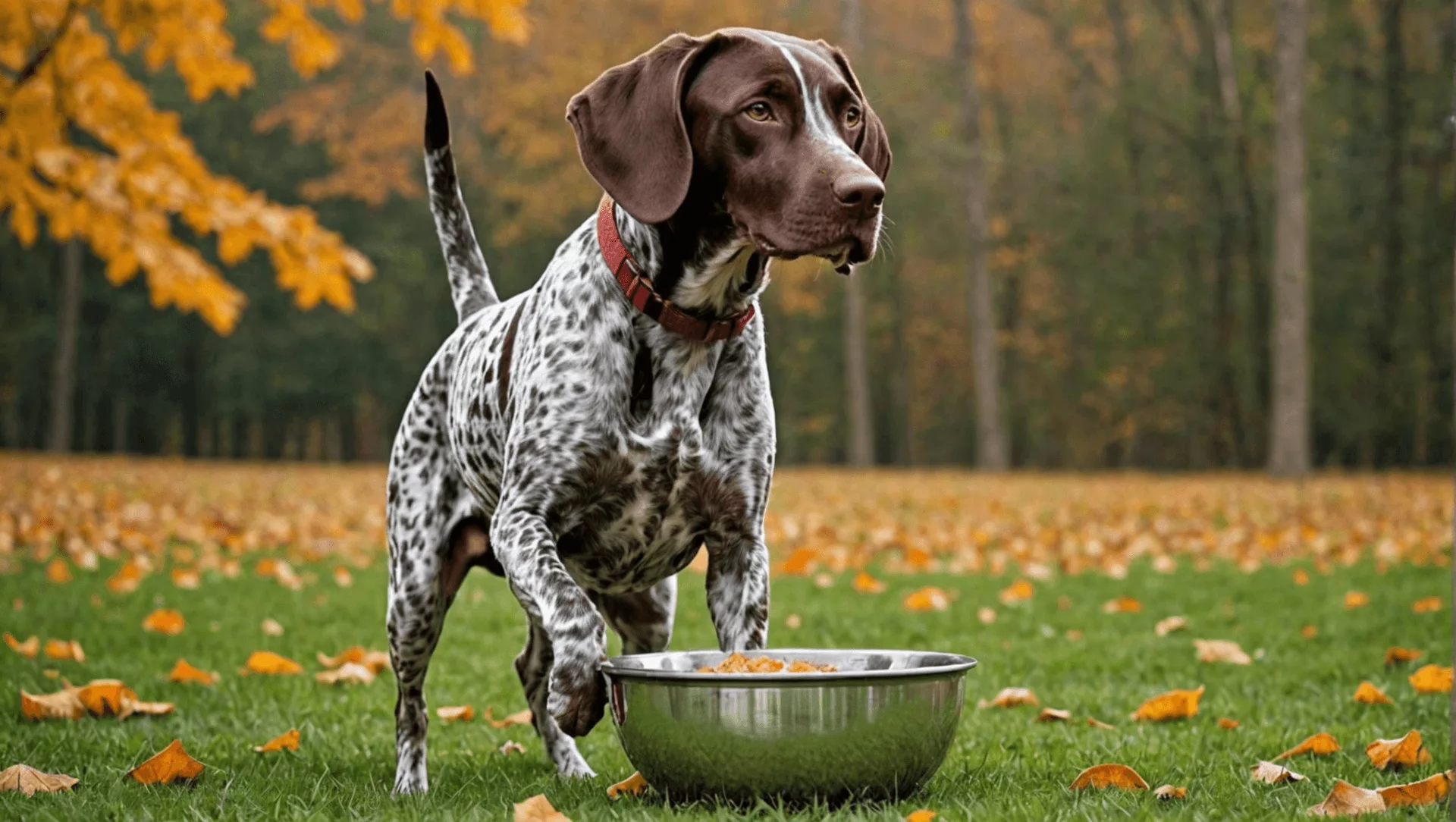For choosing the best dog food for GSP, every bite counts! German Shorthaired Pointers are known for their boundless energy and playful nature, but did you know that the right nutrition is key to keeping them happy and healthy? Selecting the best food helps ensure your GSP thrives, preventing common health issues and supporting their active lifestyle.
If you overlook the importance of their diet, your furry friend may face weight gain, poor digestion, or even joint problems. In this guide, we’ll explore the top dog food options specifically tailored for German Shorthaired Pointers, discuss feeding guidelines, and highlight the benefits of raw feeding. Whether you’re a first-time dog owner or simply looking to improve your pup’s meals, keep reading to discover how to provide the nutrition your GSP needs for a long and lively life!
Quick Recommendations:
- Royal Canin for German Shorthaired Pointers: Precise nutrition for muscular health, fiber-rich for digestion, ideal for breed-specific needs.
- Hill’s Science Diet for Active Breeds: Expert-recommended, promotes lean muscle, supports high energy levels.
- Blue Buffalo Wilderness Blend: High-protein, grain-free, fuels active adventures with natural ingredients.
- Purina Pro Plan Performance Formula: Supports athletic performance, enhances muscle recovery, perfect for active canines.
- Canidae PURE Limited Ingredient: Simplifies nutrition, aids sensitive digestion, crafted for dogs with allergies.

Understanding the German Shorthaired Pointer (GSP)
Characteristics of the German Shorthaired Pointer
The German Shorthaired Pointer (GSP) is a medium-sized dog known for its athleticism and versatility. GSPs usually stand between 24 to 28 inches tall. Their strong and muscular build makes them ideal for activities like hunting and retrieving. GSPs feature a dense, short coat that comes in various colors, including brown, black, or white, often displaying unique patterns or flecks (Chewy, 2024).
Common Health Problems in GSPs
GSPs are healthy but can be prone to several genetic health issues. Common problems include:
- Cataracts: This eye condition may lead to vision loss.
- Hip Dysplasia: This genetic condition means the hip joint does not fit properly into the socket, causing pain and mobility issues.
- Neurological Diseases: Some GSPs may experience specific neurological conditions.
On average, GSPs live around 13.4 years, which is slightly above the average for dog breeds. Regular veterinary check-ups and a healthy lifestyle can help manage these risks.
Activity Level and Dietary Needs of the GSP
GSPs possess high energy levels and require plenty of exercises to stay healthy and happy. A good daily routine includes vigorous activities like running, swimming, and playing fetch.
Their active lifestyle causes a high-quality, protein-rich diet to support their energy needs. It is best to feed GSPs foods specifically planned for medium to large breed dogs. These diets should offer balanced nutrition, maintaining muscle and bone health, while providing the right amounts of calories, fats, and essential nutrients.
Feeding guidelines suggest GSPs may need about 2-3 cups of food daily, split into two meals, depending on their age and weight.
By understanding the characteristics, health challenges, and dietary needs of GSPs, owners can provide better care for these energetic and versatile dogs.
Comparison of Dog Food for German Shorthaired Pointers
This comparison highlights the best dog food options specifically formulated for German Shorthaired Pointers, focusing on their unique nutritional needs and supporting a healthy, active lifestyle.
| Image | Product | Features | Best For | Price |
|---|---|---|---|---|
 | Royal Canin German Shepherd Adult Dog Food | • Tailored protein levels for muscle growth • Supports bone and joint health • Enhanced immune system support | Large breeds needing specialized nutrition | CHECK PRICE |
 | Hill's Science Diet Senior Dog Food | • Supports lean muscle and healthy body weight • Omega-6 fatty acids for skin and coat health • Balanced nutrition for senior dogs | Senior dogs needing specialized nutrients | CHECK PRICE |
 | Blue Buffalo Life Protection Formula | • Real meat as the first ingredient • Whole grains for sustained energy • Balanced vitamins and minerals | Active dogs needing quality nutrition | CHECK PRICE |
 | Purina Pro Plan Savor Sensitive Stomach Adult Dog Food | • Optimal protein sources for sensitive stomachs • Prebiotic fiber for digestive health • Supports overall well-being | Dogs with sensitive digestive issues | CHECK PRICE |
 | Canidae All Life Stages Multi-Protein Recipe Dog Food | • Multiple protein sources for balanced nutrition • Nutrient-dense for energy and vitality • Probiotics for gut health | Dogs of all life stages | CHECK PRICE |
This comparison provides insights into the best dog food options tailored for German Shorthaired Pointers. The selections are designed to ensure your dog receives the necessary nutrition for a healthy and active life. Choose wisely to meet your canine companion’s dietary needs.

Best Dog Food Options for German Shorthaired Pointers
Choosing the right dog food for German Shorthaired Pointers (GSPs) is crucial for their health and energy. Here are some of the best options available:
1. Royal Canin
 CHECK PRICE
CHECK PRICE
Royal Canin provides breed-specific nutrition tailored for GSPs. This dog food includes specially selected protein sources and digestible fibers to support digestion and overall health.
Key Features:
- Tailored protein levels to help muscle growth
- Digestible fibers for healthy digestion
- Antioxidants to boost the immune system
2. Hill’s Science
 CHECK PRICE
CHECK PRICE
Overview: Hill’s Science offers veterinarian-recommended formulas that ensure balanced nutrition. These recipes focus on optimal protein levels essential for GSP muscle maintenance.
Key Features:
- High-quality protein to support muscle health
- Enriched with vitamins and minerals for overall wellness
- Formulated by veterinarians for balanced nutrition
3. Blue Buffalo
 CHECK PRICE
CHECK PRICE
Overview: Blue Buffalo features a recipe rich in high-quality protein and whole grains, meeting the energy needs of active GSPs. This food promotes a well-rounded diet that supports an active lifestyle.
Key Features:
- Real meat as the first ingredient for protein
- Whole grains for sustained energy and fiber
- No artificial preservatives or by-products
4. Purina Pro
 CHECK PRICE
CHECK PRICE
Overview: Purina Pro offers a wide range of dog foods focused on performance and health. Veterinarians frequently recommended this brand because of its quality ingredients that support the energetic lifestyle of GSPs.
Key Features:
- High-quality protein sources for powerful muscles
- Formulated for digestive health
- Contains omega fatty acids for a healthy skin and coat
5. Canidae
 CHECK PRICE
CHECK PRICE
Overview: Canidae provides a multi-protein formula that supports energy and overall health, making it suitable for GSPs. The focus on high-quality ingredients ensures balanced nutrition.
Key Features:
- Multiple protein sources for balanced nutrition
- Nutrient-dense ingredients to support energy levels
- Probiotics to aid digestion
These brands—Royal Canin, Hill’s Science, Blue Buffalo, Purina Pro, and Canidae—offer high-quality dog food options designed to meet the unique needs of GSPs. Each provides tailored nutrition essential for maintaining a healthy lifestyle.

Feeding Guidelines for Your German Shorthaired Pointer
How Much Food to Feed a GSP
Adult German Shorthaired Pointers (GSPs) typically need about 2 to 3 cups of high-quality dog food each day. This amount should be divided into two meals. The exact quantity depends on the dog’s age, weight, and activity level. For example:
- Active GSPs: May require closer to 3 cups.
- Less Active GSPs: Should have around 2 cups to avoid weight gain.
Regularly monitoring the dog’s weight and adjusting portions is essential. Consulting with a veterinarian can help determine the best feeding amount for each GSP.
Best Practices for Feeding Your GSP
Feeding practices are crucial for a GSP’s health. Here are some recommended practices:
- Consistency: Feed the dog at the same times each day to help regulate metabolism and prevent overeating.
- Fresh Water: Always provide access to clean water. Hydration is vital for overall health.
- Quality Food: Choose high-quality dog food that meets the nutrition needs of active breeds. Look for foods with high protein (20-30%) and moderate fat (8-15%).
- Regular Exercise: Ensure the dog receives regular exercise, which is important for maintaining a healthy weight and overall well-being.
Weight Management Strategies for GSPs
Managing weight is important for GSP health. Here are effective strategies:
- Regular Weigh-Ins: Monitor the dog’s weight weekly or monthly to identify significant changes early.
- Adjust Portions: If the dog gains weight, slightly reduce food portions gradually to avoid digestive issues.
- Incorporate Exercise: Regular exercise is essential for burning calories. Activities like running, walking, or playing fetch are great for GSPs.
- Consult a Veterinarian: If there are significant weight changes, seek advice from a veterinarian for tailored guidance and to rule out health issues.
By following these feeding guidelines, GSP owners can help their dogs maintain a healthy weight and enjoy a happy, active life.
- American Kennel Club
- PetMD

Benefits of Raw Feeding for German Shorthaired Pointers
Understanding Raw Feeding for GSPs
Raw feeding means giving dogs’ uncooked meat, bones, and vegetables. This approach aims to mimic what dogs would naturally eat in the wild. For German Shorthaired Pointers (GSPs), who are energetic, raw feeding can support their active lifestyle. However, it is crucial to ensure that the raw diet is balanced and contains all necessary nutrients.
Nutritional Advantages of Raw Diets
Raw diets can offer several benefits for GSPs:
- Improved Coat Condition: Many GSP owners notice their dogs have shinier and healthier coats on raw diets. The higher levels of omega-3 fatty acids in raw meats and fish may contribute to this improvement.
- Increased Energy Levels: Raw diets are rich in protein, which can enhance the overall energy levels of active breeds, like GSPs. This extra energy supports their daily exercise and activities.
- Reduced Allergies: Some GSPs may experience fewer allergies when switched to a raw diet. The absence of fillers and artificial ingredients in certain commercial dog foods can help decrease allergic reactions in sensitive dogs.
Potential Risks and Considerations for Raw Feeding
While raw feeding has its advantages, there are risks to consider:
- Bacterial Infections: Raw meat can carry bacteria like Salmonella or E. coli, which can harm both dogs and humans. Safe handling and hygiene are crucial.
- Nutritional Imbalance: Without careful planning, a raw diet might lack essential nutrients. GSP owners should consult with a veterinarian to ensure the diet meets all of their dog’s nutritional needs.
- Digestive Issues: Some dogs may struggle to adjust to a raw diet, leading to digestive problems like diarrhea. Gradual transitions to raw feeding are recommended to help dogs adapt.
Raw feeding for GSPs can enhance coat health and boost energy. However, awareness of the risks is essential, along with ensuring a balanced diet. Consulting a veterinarian before making significant dietary changes is always a good practice to maintain the health and happiness of GSPs.

Transitioning to New Dog Food for GSPs
Changing a dog’s food is an important step for their health. For German Shorthaired Pointers (GSPs), this transition must be done carefully. GSPs are active dogs, and their nutrition is vital for maintaining energy and overall health. Below are best practices for switching dog food, signs of change, and tips for troubleshooting issues during the transition.
Best Practices for Switching Dog Food
To help your GSP adjust to new dog food, follow these best practices:
- Start Slowly: Mix a small amount of the new food with the old food. A good starting ratio is 25% new food and 75% old food for the first few days.
- Increase Gradually: Over the next week, slowly increase the new food amount. Aim for a 50% new food and 50% old food ratio by the end of the week.
- Monitor Digestive Health: Watch for any signs of upset stomach, such as vomiting or diarrhea. If these occur, slow down the transition process.
- Maintain Consistency: Feed your GSP at the same times each day to establish a routine. GSPs thrive on consistency, which can aid in the transition.
- Consult a Veterinarian: If there are concerns or if your dog has special dietary needs, seek advice from a veterinarian about the best food and transition plan.
Signs Your GSP Is Adjusting to New Food
As the transition progresses, look for these signs that your GSP is adjusting well:
- Increased Energy: A GSP with more energy is often a sign that the new food is meeting their nutritional needs.
- Healthy Coat: A shiny coat with less shedding shows good nutrition and health.
- Normal Stool: Consistent and firm stool is a good indicator of proper digestion.
- Good Appetite: Excitement at mealtime suggests your GSP enjoys the new food.
Troubleshooting Feeding Issues with GSPs
Sometimes, feeding issues may arise during the transition. Here are common problems and their solutions:
- Digestive Upset: If your GSP has vomiting or diarrhea, consider slowing the transition and giving more time to the old food before introducing more of the new food.
- Loss of Appetite: If your dog refuses to eat the new food, try warming it slightly or mixing in a small amount of wet food to enhance its appeal.
- Signs of allergies: Watch for itching, redness, or other allergy symptoms. If these occur, consult a veterinarian to determine if a fresh food is necessary.
- Weight Changes: Regularly monitor your GSP’s weight during the transition. If your dog is gaining too much weight, adjust the portions or consider a lower-calorie food option.
By following these guidelines, GSP owners can help their dogs transition smoothly to new food, ensuring they maintain health and energy levels. Prioritizing a dog’s well-being during dietary changes is essential.

Comparing Commercial vs. Raw Dog Food for GSPs
Choosing the best dog food for a German Shorthaired Pointer (GSP) often means comparing commercial dog food and raw feeding. This section explores the advantages and disadvantages of each option, helping pet owners make informed decisions.
Pros and Cons of Commercial Dog Food
Commercial dog food has various benefits and drawbacks for GSPs.
Pros:
- Balanced Nutrition: Commercial dog foods meet nutritional standards set by the Association of American Feed Control Officials (AAFCO). They offer a mix of proteins, fats, carbohydrates, vitamins, and minerals essential for a GSP’s health.
- Convenience: These foods are easy to find and purchase, requiring no preparation. This makes feeding time quick and hassle-free for busy pet owners.
- Safety and Quality Control: Established brands follow strict safety guidelines, reducing the risk of contamination or nutritional imbalances. Many products undergo thorough testing before they hit the market.
Cons:
- Fillers and Artificial Ingredients: Some commercial dog foods contain fillers like corn and soy, along with artificial preservatives, colors, and flavors. These ingredients may provide little nutrition and can trigger allergies in some dogs.
- Less Customization: Commercial diets typically follow a standard formula that might not meet the unique health needs of every GSP, especially those with food allergies or specific dietary requirements.
Benefits and Drawbacks of Raw Feeding
Raw feeding is increasingly popular among dog owners who seek more natural nutrition options.
Benefits:
- Natural Ingredients: Raw diets often feature unprocessed meats, bones, fruits, and vegetables. This can provide a more natural source of nutrients, potentially enhancing a dog’s overall health.
- Higher Protein Content: Raw diets usually contain elevated protein levels, which are beneficial for active breeds like GSPs that require extra energy.
- Improved Coat and Health: Many owners observe shinier coats and better overall health in dogs fed a raw diet.
Drawbacks:
- Preparation Time: Crafting a balanced, raw diet requires careful planning and preparation. Owners must ensure the diet includes the right mix of nutrients to avoid deficiencies.
- Risk of Bacterial Infections: Raw meat can carry bacteria like Salmonella or E. coli, which can harm both dogs and humans. Proper handling and hygiene are vital when feeding raw.
- Nutritional Imbalances: If a raw diet is not meticulously balanced, it may lead to nutritional issues that can adversely affect a GSP’s health. Consulting a veterinarian is crucial before starting a raw feeding plan.
Which Is Best for Your GSP?
Choosing the best dog food for a German Shorthaired Pointer depends on individual circumstances and specific health needs. It’s important to consider factors such as age, activity level, and any dietary restrictions your dog may have. Additionally, while searching for the best dog food for labradoodles might not directly relate to your German Shorthaired Pointer, it highlights the importance of tailoring diets to each breed’s unique characteristics. Consulting with a veterinarian can also provide valuable insights into selecting a food that supports optimal health and wellbeing.
- For Active GSPs: High-quality commercial foods designed for active breeds can supply the nutrients and energy for their lifestyle.
- For Dogs with Specific Health Concerns: Raw feeding may suit GSPs with allergies or sensitivities requiring a more tailored diet. Always consult a veterinarian to ensure nutritional adequacy.
Both feeding methods have distinct advantages and challenges. Pet owners should consider their lifestyle and their dog’s health while consulting a veterinarian when deciding between commercial and raw diets.
Conclusion
In this guide, we explored everything you need to know about feeding your German Shorthaired Pointer (GSP). Understanding their unique characteristics and dietary needs is essential for their health. We also highlighted some of the best dog food options available, like Royal Canin and Blue Buffalo, which can help support your GSP’s active lifestyle.
For feeding, always keep in mind the right portion sizes and best practices for weight management. Whether you choose a commercial diet or consider the benefits of raw feeding, providing a balanced meal is key.
Now that you have the tools to make informed choices, your GSP is on their way to a happy and healthy life! Keep exploring and learning about the best nutrition for your furry friend!

